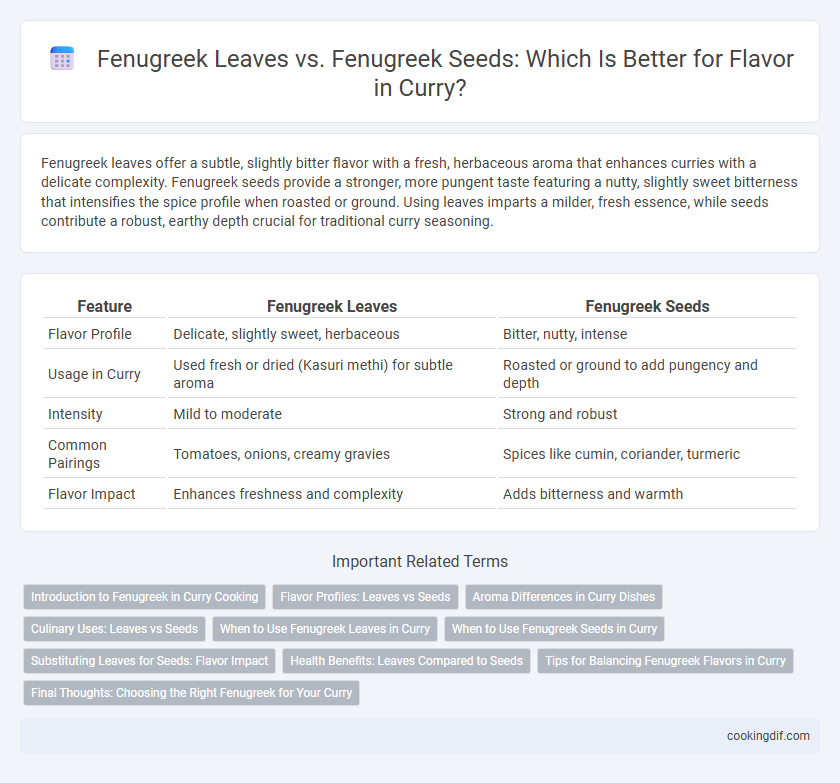Fenugreek leaves offer a subtle, slightly bitter flavor with a fresh, herbaceous aroma that enhances curries with a delicate complexity. Fenugreek seeds provide a stronger, more pungent taste featuring a nutty, slightly sweet bitterness that intensifies the spice profile when roasted or ground. Using leaves imparts a milder, fresh essence, while seeds contribute a robust, earthy depth crucial for traditional curry seasoning.
Table of Comparison
| Feature | Fenugreek Leaves | Fenugreek Seeds |
|---|---|---|
| Flavor Profile | Delicate, slightly sweet, herbaceous | Bitter, nutty, intense |
| Usage in Curry | Used fresh or dried (Kasuri methi) for subtle aroma | Roasted or ground to add pungency and depth |
| Intensity | Mild to moderate | Strong and robust |
| Common Pairings | Tomatoes, onions, creamy gravies | Spices like cumin, coriander, turmeric |
| Flavor Impact | Enhances freshness and complexity | Adds bitterness and warmth |
Introduction to Fenugreek in Curry Cooking
Fenugreek leaves and fenugreek seeds both play distinct roles in curry cooking, contributing unique flavors and aromas. Fenugreek leaves offer a subtle, slightly bitter taste that enhances the overall complexity of curries, especially in Indian and Middle Eastern cuisines. Fenugreek seeds provide a stronger, more pungent flavor with a hint of sweetness, often toasted to release their intense aroma and deepen the curry's flavor profile.
Flavor Profiles: Leaves vs Seeds
Fenugreek leaves offer a mild, slightly sweet, and herbaceous flavor with hints of celery and spinach, making them ideal for fresh, green notes in curries. Fenugreek seeds possess a more intense, bitter, nutty, and slightly maple-like flavor, which deepens and intensifies when toasted, adding warmth and complexity to dishes. The choice between leaves and seeds significantly influences the curry's overall aroma and taste, with leaves imparting subtle freshness and seeds providing robust, earthy undertones.
Aroma Differences in Curry Dishes
Fenugreek leaves impart a subtle, fresh aroma with slightly bitter and nutty notes that brighten curry dishes, while fenugreek seeds offer a stronger, earthy fragrance with a warm, maple-like scent that intensifies during roasting. The volatile compounds in fenugreek seeds release a richer, more pungent aroma, making them ideal for grounding curries with deep, complex flavors. Using fenugreek leaves results in a lighter, herbaceous aroma that complements delicate spice blends and adds freshness to the curry's profile.
Culinary Uses: Leaves vs Seeds
Fenugreek leaves impart a mild, slightly bitter, and aromatic flavor, enhancing dishes like Indian curries, dals, and vegetable stir-fries with a fresh, herbaceous note. Fenugreek seeds have a stronger, more pungent, and slightly sweet bitterness, commonly toasted or ground to add depth and warmth to spice blends such as garam masala and curry powders. While fenugreek leaves are primarily used fresh or dried for garnishing and flavoring, fenugreek seeds are often used whole or powdered during cooking to infuse oil and create a complex base flavor.
When to Use Fenugreek Leaves in Curry
Fenugreek leaves bring a mild, slightly bitter aroma and are best used in the final stages of cooking curries to preserve their delicate flavor and vibrant green color. Fresh or dried fenugreek leaves add a subtle earthiness that complements tomato-based and lentil curries without overpowering other spices. Using fenugreek leaves late in the process enhances the curry's depth while fenugreek seeds offer a stronger, nutty bitterness suited for initial tempering.
When to Use Fenugreek Seeds in Curry
Fenugreek seeds offer a robust, slightly bitter flavor that intensifies when dry-roasted and are best used early in the cooking process to infuse curries with a deep aromatic base. Incorporating fenugreek seeds at the beginning of cooking allows their complex, nutty notes to meld with spices and vegetables, enhancing the overall depth of the curry. Using seeds rather than leaves targets recipes requiring a strong, earthy undertone, such as lentil or meat-based curries, where they complement slow-simmered flavors.
Substituting Leaves for Seeds: Flavor Impact
Fenugreek leaves provide a milder, more herbaceous flavor compared to the stronger, slightly bitter taste of fenugreek seeds, making leaves a subtle alternative in curries. When substituting leaves for seeds, the intensity of bitterness decreases, resulting in a fresher, less pungent aroma and taste. Adjusting quantity is essential because fenugreek leaves lose potency when dried, so using a larger amount than seeds helps balance flavor profiles effectively.
Health Benefits: Leaves Compared to Seeds
Fenugreek leaves contain higher levels of antioxidants and vitamins such as vitamin C and vitamin K, which support immune function and bone health, while fenugreek seeds are richer in fiber and alkaloids beneficial for digestion and blood sugar regulation. The leaves offer anti-inflammatory properties that can help reduce cholesterol and improve heart health more effectively than the seeds. Both forms provide unique health benefits, but fenugreek leaves are preferred for enhancing antioxidant intake and supporting overall wellness.
Tips for Balancing Fenugreek Flavors in Curry
Fenugreek leaves impart a mild, slightly sweet aroma while fenugreek seeds deliver a more intense, bitter flavor essential for curry depth. To balance fenugreek flavors in curry, use dried fenugreek leaves sparingly near the end of cooking to preserve their delicate taste and add fenugreek seeds early in hot oil to mellow their bitterness. Combining both forms with complementary spices like cumin and coriander helps achieve a harmonious, well-rounded curry flavor profile.
Final Thoughts: Choosing the Right Fenugreek for Your Curry
Fenugreek leaves offer a mild, slightly sweet and aromatic flavor, ideal for enhancing curries with a delicate herbal note, while fenugreek seeds provide a robust, bitter, and nutty taste that deepens the curry's complexity. Using fenugreek leaves, often called kasuri methi, is perfect for finishing dishes or tempering, imparting a fresh and subtle fragrance. Fenugreek seeds, when toasted and ground, unlock intense flavor and bitterness, best suited for initial cooking stages to build a rich and balanced curry base.
Fenugreek leaves vs Fenugreek seeds for flavor Infographic

 cookingdif.com
cookingdif.com